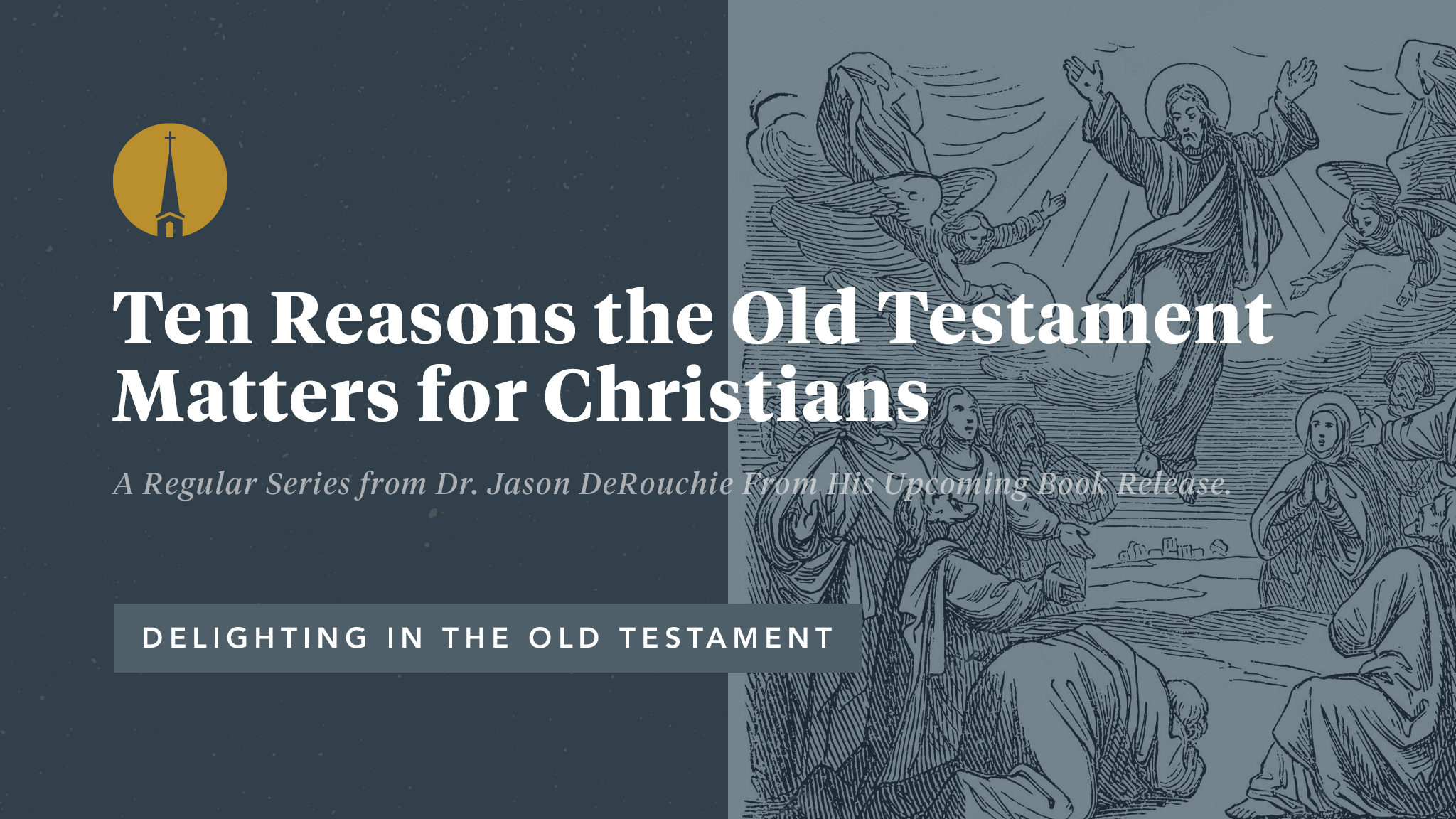
Is Christ really part of the Old Testament? Should I as a believer in the twenty-first century claim Old Testament promises as mine? Does the Mosaic law still matter today for followers of Jesus? Is the Old Testament Christian Scripture, and if so, how should we approach it?
This blog series on Delighting in the Old Testament seeks to help Christians make connections to Christ and practical application to the Christian life from every page of the Old Testament. More specifically, it seeks to help you:
-
• by faith see and celebrate Christ in the Old Testament in faithful ways,
• rightly hope in Old Testament promises through Jesus, and
• genuinely love others with the help of the old-covenant law and its fulfillment in Jesus.
To understand the Old Testament fully, we must read it as believers in Jesus, with God having awakened our spiritual senses to see and hear rightly. That is, we read through Christ. Then, as Christians, biblical interpretation reaches its end only after we have found Jesus and experienced him transforming us into his image. We, thus, read for Christ.
Some Christians may query, if we are part of the new covenant, why should we seek to understand and apply the Old Testament? While I will develop my response throughout this blog series, I give ten reasons here why the “Old” in Old Testament must not mean “unimportant or insignificant.”
1. The Old Testament Was Jesus’s Only Bible and Comprises 75% of Christian Scripture
If space says anything, the Old Testament matters to God, who gave us his word in a Book. In fact, it was his first special revelation, and it set a foundation for the fulfillment we find in Jesus in the New Testament. The Old Testament was the only Bible of Jesus and the earliest church (e.g., Luke 24:44; Acts 24:14), and it is a major part of our Scriptures.
2. The Old Testament Influences Our Understanding of Key Biblical Teachings
Without the Old Testament, we wouldn’t understand the problem for which Jesus and the New Testament supply the solution (Rom 5:18). We would miss so many features of God’s salvation story (9:4–5). And we wouldn’t grasp the various types and shadows that point to Jesus (John 1:29; 2:19, 21). Furthermore, some doctrines, such as the doctrine of creation, are best understood only from the Old Testament (Gen 1:1–2:3). Finally, the New Testament worldview and teachings are built upon the framework supplied in the Old Testament.
3. We Meet the Same God in Both Testaments
Note how the book of Hebrews begins: “Long ago, at many times and in many ways, God spoke to our fathers by the prophets, but in these last days he has spoken to us by his Son” (Heb 1:1–2). The very God who spoke through Old Testament prophets speaks through Jesus!
Isn’t the Old Testament’s God one of wrath, though, whereas the God of the New Testament is about grace? Not exactly. In brief, God is as wrathful in the New Testament as he is in the Old (e.g., Matt 10:28), and the Old is filled with manifestations of God’s saving grace (e.g., Exod 34:6). Certainly, there are numerous expressions of Yahweh’s righteous anger in the Old Testament, just as there are massive manifestations of blood-bought mercy in the New. Nevertheless, what is important is to recognize that we meet the same God in the Old Testament as we do in the New.
4. The Old Testament Announces the Very “Good News” We Enjoy
Paul stresses that the Lord “promised beforehand through his prophets in the holy Scriptures” the very powerful “gospel of God” (Rom 1:1–2; cf. Gal 3:8). Foremost among these prophets was Isaiah, who anticipated the day when Yahweh’s royal Servant (the Messiah) would herald comforting “good news” to the poor and broken (Isa 61:1; cf. 40:9–11; 52:7–10; Luke 4:16–21). Reading the Old Testament, therefore, is one of God’s given ways for us to better grasp and delight in the gospel (see also Heb 4:2).
5. Both Testaments Call Us to Love and Clarify What Love Looks Like
As with Israel, the Lord calls Christians to lives characterized by love (Deut 6:5; 10:19; Matt 22:37–40; cf. 7:12; Rom 13:8, 10; Gal 5:14). However, he now gives all members of the new covenant the ability to do what he commands. As Moses himself asserted, the old-covenant law called for life-encompassing love (Deut 30:6), and Christians today can gain clarity from the Old Testament on the wide-ranging impact of love in all of life. As we will see, this happens rightly only when we account for how Jesus fulfills every particular law.
6. Jesus Came Not to Set Aside the Old Testament but to Fulfill It
Far from setting aside the Old Testament, Jesus stressed that he came to fulfill it, and he highlighted how the Old Testament’s instruction was lastingly relevant for his followers (Matt 5:17–19). In later posts we’ll consider further the significance of this text, but what is important to note here is that, while the age of the old covenant has come to an end (Rom 6:14–15; 1 Cor 9:20–21; Gal 5:18; cf. Luke 16:16), the Old Testament itself maintains relevance for us in the way it (a) displays the character of God (e.g., Rom 7:12), (b) points to the excellencies of Christ, and (c) portrays for us the scope of love in all its facets (Matt 22:37–40).
7. Jesus Said That All the Old Testament Points to Him
Jesus himself said, “You search the Scriptures because you think that in them you have eternal life; and it is they that bear witness about me” (John 5:39; cf. 1:45; 5:46–47). Then, following his resurrection, he opened his disciples’ minds “to understand the Scriptures, and said to them, ‘Thus it is written that the Christ should suffer and on the third day rise from the dead, and that repentance and forgiveness of sins should be proclaimed in his name to all nations, beginning from Jerusalem” (Luke 24:53; cf. 24:27; Acts 26:22–23; 1 Cor 2:2). A proper “understanding” of the Old Testament will lead one to hear in it a message of a suffering and resurrected Messiah and the mission his life would generate.
8. The New Testament Authors Expect Us to Read the Old Testament
The New Testament often cites the Old Testament in ways that call us back to look at the original context. For example, Matthew 27–28 portray Christ’s tribulation and triumph at the cross by recalling Psalm 22 many times. Jesus quotes Psalm 22:1 when he declares, “My God, my God, why have you forsaken me?” (Matt 27:46). In stating, “And when they had crucified him, they divided his garments among them by casting lots” (Matt 27:35), Matthew alludes to Psalm 22:16, 18, which reads: “They have pierced my hands and feet…. They divide my garments among them, and for my clothing they cast lots.” To fully understand their words, the New Testament authors call us back to the Old Testament through their quotations and allusions.
9. The New Testament Authors Recognized That God Gave the Old Testament for Christians
Regarding the Old Testament prophets, Peter identifies, “It was revealed to them that they were serving not themselves but you” (1 Pet 1:12). Similarly, Paul was convinced that the Old Testament authors wrote for new-covenant believers—those following Jesus on this side of his death and resurrection. “For whatever was written in former days was written for our instruction, that through endurance and through the encouragement of the Scriptures we might have hope” (Rom 15:4; cf. 4:23–24; 1 Cor 10:11).
10. Paul Demands That Church Leaders Preach the Old Testament
Significantly, Paul was referring to the Old Testament when he spoke of the “sacred writings” that are able to make a person “wise for salvation” and of the “Scripture” that is “breathed out by God and profitable” (2 Tim 3:15–16). Knowing this fact colors our understanding of his charge in 2 Timothy 4:2–4. In short, Paul believed Christians like Timothy needed to preach the Old Testament to guard the church from apostasy. While we now have the New Testament, we still must study, practice, and teach the Old Testament like Jesus and his apostles did for the good of God’s church.
Conclusion
This Delighting in the Old Testament series seeks to supply believers with an interpretive framework and guide for rightly handling the Old Testament as God’s Word for us (2 Tim 2:15). It approaches the Old Testament through Christ and for Christ. The series will develop in four stages, each with three to four posts. Stage 1 calls for reading well the Old Testament by interpreting it through and for Christ. Stage 2 then develops this call by indicating how Christians can see well Christ’s person and work within the Old Testament. Stage 3 considers how to hope well in Old Testament promises, which through Christ become certain for all who are in the church. Finally, Stage 4 overviews how to live well by applying Old Testament laws in view of how Christ fulfills them.
–––––
The blog series summarizes Jason S. DeRouchie’s forthcoming book, Delighting in the Old Testament: Through Christ and for Christ (Wheaton, IL: Crossway, 2024). You can pre-order your copy here.

